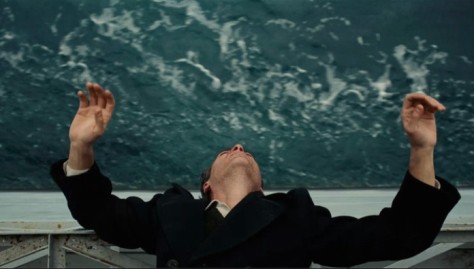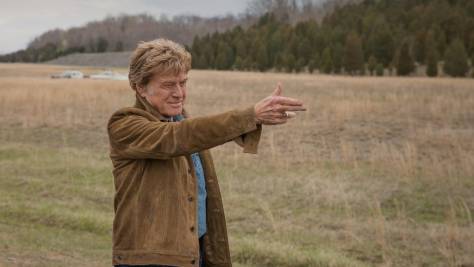By Dennis Hartley
(Originally posted on Digby’s Hullabaloo on November 2, 2019)

When I was in the 6th Grade at Ft. Wainwright Junior High in Alaska, everyone in class was assigned to choose, memorize and recite a Robert Service poem (I’m assuming this is a uniquely Alaskan rite of passage…although I can’t speak for public school traditions in the Yukon Territories). As most Robert Service poems go on longer than the Old Testament, this is not a casual assignment. My choice… “The Shooting of Dan McGrew”.
Then his lips went in a kind of grin, and he spoke, and his voice was calm,
And “Boys,” says he, “you don’t know me, and none of you care a damn;
But I want to state, and my words are straight, and I’ll bet my poke they’re true,
That one of you is a hound of hell…and that one is Dan McGrew.”
There’s a lot more to it, involving a gal named Lou and how this miner dude (“fresh from the creeks, dog-dirty, and loaded for bear”) gallivants into the local saloon like Rocky Racoon lookin’ for trouble but I think I probably chose it because it gave me an opportunity to work “blue” in front of the class without being admonished by the teacher.
Flash-forward to my junior year of high school. Specifically, that is when I bought an LP called Dolemite for President completely on a whim (OK…the somewhat prurient nature of the album cover and the fact that they kept it behind the counter may have initially piqued my interest). I was also really into comedy albums at the time, and the record store clerk assured me that this obscure comic Rudy Ray Moore was a laugh riot.
I had absolutely no idea what to expect. I smuggled it home (I definitely did not want my parents to see the album cover, and intuitively figured it would be wise to listen with headphones). The track list was intriguing; with cuts like “Dance of the Freaks”, “Farting Contest”, “Long Island Duck”, “Sit in Your Mama’s Lap” (you can ah…Google the rest).
Side 1 opens with Moore in character as presidential hopeful “Dolemite”, who gives an expletive-laden campaign speech touting his (very!) progressive platform (inspiration for Bullworth?) From a stylistic standpoint it was a fairly standard-issue standup monologue.
But the next cut, “Stack-A-Lee”, was…poetry.
Billy said “Stack? You’re takin’ my money, so get on your knees and pray
With your life…you’re gonna have to pay.”
Stack said “Billy…are you for real? I want you to listen, and listen well
I’m the bad motherfucker that blows the devil out of hell!”
I wasn’t able to contextualize “why” at the time, but it somehow reminded me of “The Shooting of Dan McGrew” (although, the miner loaded for bear didn’t refer to himself as “the bad motherfucker that blows the devil out of hell” while calling out Dan Mcgrew).
Most bits on the album turned out to be in rhymes. Filthy, dirty rhymes. I laughed and laughed and became a Rudy Ray Moore fan. He was fresh and original; and his incorporation of long-form verse was more developed than “There once was a girl from Nantucket…” Like Redd Foxx meets The Last Poets (or Robert Service with Tourette’s).
Flash-forward 47 years (jeezus) and I’m doing background research for my review of the 2019 Moore biopic, Dolemite Is My Name. I was surprised to learn from the film that Moore’s rhyming style was not 100% “original”, after all. Rather, it was rooted in an African American oral tradition called “toasting” (not to be confused with “Here’s to your health!”). I came across this enlightening 2004 University at Buffalo news release:
“Get Your Ass in the Water and Swim Like Me: Narrative Poetry From Black Oral Tradition,” a book collected and compiled by SUNY Distinguished Professor Bruce Jackson of the University at Buffalo, is back for a second go ’round. […]
The book collects a popular form of African American literature and folk poetry known as “toasts.” For 30 years, it carried the reputation of a “stone cold classic,” mightily praised by critics, cultural historians, musicians, poets and general-interest readers alike. The book includes a new CD of Jackson’s original field recording of the toasts in the book.
“Toasts are just one aspect of a rich tradition of verbal arts in black culture,” Jackson says. “Public performance of rhyming verse has ancient African roots. And we see it now in rap and hip-hop, which are a mix of African American, Caribbean and several other traditions.
“Toasts are the starting point for rap,” he says, “both in the poetry itself and the way it was used and performed in public situations. As the novelist and former Buffalonian Ishmael Reed says, if you want to understand rap and hip-hop, you’ve got to understand toasts.”
The toasts featured in the book, says Jackson, come from various sources, including street corners, barber shops, bars and jails — “places young men hang around without much to do.”
Although Jackson says the stories told in these works can be personal and intimate — and he has heard blues lyrics and Robert Service poems recited as toasts — they generally celebrate a number of folkloric figures from African-American culture like “Stackolee,” the famed bad man said to have murdered a guy over a Stetson hat […]
Hmm. After reading that, I dug deeper. The first documented reference to a song called “Stack-a-Lee” (by “Prof. Charlie Lee, the piano-thumper”) was in the Kansas City Leavenworth Herald in 1897. Robert Service published “The Shooting of Dan McGrew” in 1907.
I don’t hold a degree in ethnomusicology or poetry, but it does raise a tantalizing possibility that Service, like Rudy Ray Moore, could have been inspired by traditional African-American toasts (all I have to do is tell the truth …and no one ever believes me).
Not that the subject of Robert Service (or his poems) ever arises in Dolemite Is My Name (running concurrently in theaters and on Netflix), but the film does impart everything you ever wanted to know (but were afraid to ask) about the late cult comedian and filmmaker.
The film was a labor of love for producer/star Eddie Murphy, who has been pitching a Moore biopic to studios for decades. Repeatedly thwarted by reticence of studio execs to green light a project about a relatively obscure entertainer, Murphy persisted until Netflix gave a nod. This adds nice symmetry to the film; as it mirrors Moore’s own perseverance.
Directed by Craig Brewer (Hustle & Flow, Black Snake Moan) and co-written by Scott Alexander and Larry Karaszewski, the film depicts how Moore (Murphy), a struggling middle-aged musician and standup eking out a living working at a Hollywood record store and moonlighting as a nightclub MC, found the “hook” that brought him notoriety.
Circa 1970, Moore begins to take “professional” interest in the storytelling skills of Ricco (Ron Cephus Jones) a wino who habitually panhandles at the record store. Ricco regales anyone who has change jangling in their pockets with the raunchy misadventures of a fictional pimp/badass named “Dolemite”. Ricco delivers his tales in the form of rhymes.
This gives Moore an epiphany; he dry-runs the “Dolemite” persona on stage one night, replete with pimp regalia, street attitude, and nasty toasts, and to his delight the audience eats it up. Word-of-mouth spreads, and the new-and-improved act makes him a local hit.
To capitalize on the unexpected career surge, Moore next sets sights on making “party records” that would surpass even the bawdiness of Redd Foxx, who at the time was one of the most popular “blue” acts that was releasing “adults only” comedy albums (although it’s not mentioned in the film, Moore had already released three traditional comedy LPs between 1959 and 1964). As he was still a relative unknown quantity outside of the African American community, Moore initially had to go the D.I.Y. route.
Once he was able to gain a wider fan base from his records, Moore decided to take it to the next logical step…the movies. The final two-thirds of Dolemite Is My Name focuses on the making of Moore’s first independent film, which was called (wait for it) Dolemite.
Bereft of studio backing or deep-pocketed investors, Moore finagles an abandoned L.A. hotel as a sound stage. He assembles a mostly amateur cast, hires some UCLA film students as crew, enlists a black consciousness-woke playwright (Keegan-Michael Key) as screenwriter, and sweet-talks an actor with some Hollywood credits named D’Urville Martin to be his director (played by a scenery-chewing Wesley Snipes).
Moore casts himself as the film’s eponymous hero, a kung-fu fighting badass pimp (this was the peak of the “blaxploitation” era, in case you hadn’t picked up on that) and his stage act partner/comedy foil Lady Reed (Da’Vine Joy Randolph) as his leading lady (made on a shoestring in 1975, every bit of Dolemite’s lack of funding and/or film-making prowess showed on the screen; nonetheless it did find an audience and became a surprise cult hit).
I was getting a strong whiff of Tim Burton’s Ed Wood while watching Brewer’s film. It immediately became clear as to “why” when I looked up Alexander and Karaszewski’s screenwriting credits and discovered Ed Wood to be among them (I’m a little slow sometimes-but I’m nothing if not intuitive).
While it doesn’t tell the complete story of Moore’s life, Dolemite Is My Name captures the essence of what he was about; mostly thanks to Murphy’s committed performance, which is the best work he has done in years.
Mind you, I wouldn’t file it under “good clean family fun”, but Dolemite Is My Name is nonetheless an entertaining, upbeat, and affectionate portrait you won’t need to hide from your parents.




















